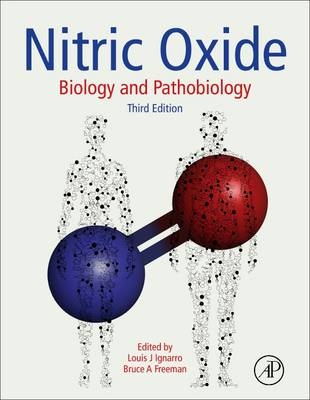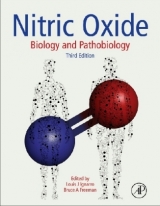
Nitric Oxide
Academic Press Inc (Verlag)
978-0-12-373866-0 (ISBN)
- Titel erscheint in neuer Auflage
- Artikel merken
Nitric oxide (NO) is a gas naturally found in the body that conveys information between cells. In the last decade researchers have found that NO is a signaling molecule of key importance for the cardiovascular system, regulating blood pressure and blood flow to different organs. In addition, discoveries surrounding nitric oxide’s role as a principal neurotransmitter moderating erectile function, a pathophysiological negotiator and messenger in inflammation, and a weapon against infections have increased research attention across the fields of biochemistry, chemistry, molecular biology, gene therapy, cell biology, immunology, pharmacology, neuroscience, and physiology.
Louis J. Ignarro, PhD, is Distinguished Professor Emeritus of the Department of Molecular and Medical Pharmacology at the UCLA School of Medicine. He has broad and extensive experience in the molecular and chemical biology of the nitric oxide-cyclic GMP signaling systems. He and his basic research teams have discovered and expanded the production and actions of nitric oxide in mammalian tissues, including the protective roles of nitric oxide in preventing hypertension, stroke and myocardial infarction, and its neurotransmitter role as the mediator of erectile function in humans. For these discoveries, he was awarded the Nobel Prize in Physiology or Medicine.
Section I. Chemical Biology
Chapter 1
Determinants of Nitric Oxide Chemistry: Impact of Cell Signaling Processes
Chapter 2
Nitric oxide redox biochemistry in lipid environments
Chapter 3
Mechanisms and biological consequences of peroxynitrite-dependent protein oxidation and nitration
Chapter 4
Systems Approaches to Unraveling Nitric Oxide Response Networks in Prokaryotes
Section II. Principles of Biology
A. Nitric Oxide Synthases
Chapter 5
Uncoupling of endothelial NO synthase (eNOS) in cardiovascular disease and its pharmacological reversal
Chapter 6
Tetrahydrobiopterin: An essential cofactor for Nitric Oxide Synthases and Amino Acid Hydroxylases
Chapter 7
Regulation of the expression of inducible nitric oxide synthase
Chapter 8
Molecular Regulation of Inducible Nitric Oxide Synthase
B. Guanylate Cyclase and Cyclic GMP
Chapter 9
Soluble Guanylate Cyclase: Allosteric Activation and Redox Regulation
C. Nitric Oxide Signaling
Chapter 10
Untargeted Discovery of NO-modified Proteins
Chapter 11
Fatty Acid Transduction of Nitric Oxide Signaling: Cyclooxygenases, Lipoxygenases and Nitro-Fatty Acids
Chapter 12
Nitric Oxide Signaling in Vascular Cells is Regulated through CD47 by Thrombospondin-1
Chapter 13
The Regulation of Cell Energetics and Mitochondrial Signaling by Nitric Oxide
D. Regulation of Nitric Oxide Production
Chapter 14
Nitric oxide-asymmetric dimethylarginine system in endothelial cell senescence
E. Nitric Oxide and Remodeling
Chapter 15
The Role of Nitric Oxide in Apoptosis and Autophagy: Biochemical and Computational Studies
F. Nitrite and Nitrate
Chapter 16
NO formation from inorganic nitrate and nitrite
Chapter 17
Mechanisms of nitrite reduction in ischemia in the cardiovascular system: therapeutic potential
Chapter 18
Nitrite Therapy for Ischemic Syndromes
Chapter 19
Nitrite and heme globins: Reaction mechanisms and physiological targets
Section III. Principles of Pathobiology
A. Nitric Oxide and Cardiovascular Function
Chapter 20
Nitric Oxide in Vascular Damage and Regeneration
Chapter 21
Free radicals as atherosclerotic risk-The relation of NO-
Chapter 22
The role of oxidative stress in endothelial dysfunction and vascular inflammation
B. Pathophysiological Mechanisms of Nitric Oxide
Chapter 23
Nitric oxide, oxidative stress, immune response and critical care
Chapter 24
Reactive Metabolites of Oxygen and Nitrogen in Liver Ischemia and Reperfusion Injury
Chapter 25
Nitric oxide in airway inflammation
Chapter 26
Novel therapeutic applications of nitric oxide (NO) in the inhibition of tumor malignancy and reversal of resistance
| Verlagsort | San Diego |
|---|---|
| Sprache | englisch |
| Maße | 216 x 276 mm |
| Gewicht | 1920 g |
| Themenwelt | Naturwissenschaften ► Biologie ► Biochemie |
| ISBN-10 | 0-12-373866-0 / 0123738660 |
| ISBN-13 | 978-0-12-373866-0 / 9780123738660 |
| Zustand | Neuware |
| Haben Sie eine Frage zum Produkt? |
aus dem Bereich



